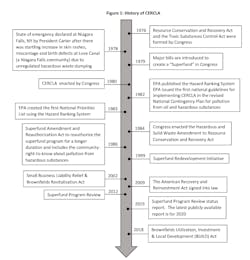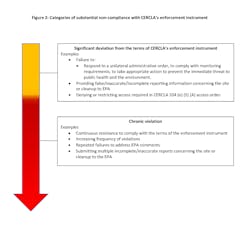What is the Comprehensive Environmental Response, Compensation, and Liability Act (CERCLA)?
Saleha Kuzniewski, Ph.D. has written on several scientific and legal issues. Kuzniewski can be reached at [email protected]
Definition of CERCLA
The term ‘CERCLA’ means the Comprehensive Environmental Response, Compensation, & Liability Act (in 42 U.S.C. §9601, Definitions). It was enacted by Congress on December 11, 1980 and authorizes remedial actions for historical and non-operational sites that pose risks to human health and the environment.
42 U.S.C., Title 42 – The Public Health & Welfare, Chapter 103 - CERCLA, Subchapters I to IV
What is in Subchapters I to IV?
Subchapter I - Hazardous Substances Releases, Liability, and Compensation
9601 to 9628 – includes a comprehensive list of definitions used in subchapters I to IV; additional designations and released quantities that must be reported for hazardous substances; who should notify and to whom when releasing hazardous substances; penalties for failure to notify and bookkeeping; responsibilities and authority for the removal and other removal action; potential responsible parties; Brownfield assessment and remediation grant programs; national contingency plan for the removal of oil and hazardous substances; hazard ranking system including adding facilities to the National Priorities List; abatement actions; liability including liability of fiduciaries; exemptions and exceptions to liability; financial responsibilities for failure to comply with this chapter and for the release of a hazardous substance as in this chapter; protection to employee for providing information about a hazardous substance in this chapter; relationship to other Federal and State laws for liability and compensation requirement for the release of hazardous substances; public participation for any proposed plan for remedial action; guidance for cleanup standards.
Subchapter II – Hazardous Substance Response Revenue
Part A – Hazardous Substance Response Trust Fund
9631 to 9633: Repealed
Part B – Post-Closure Liability Trust Fund
9641: Repealed
Subchapter III – Miscellaneous Provisions
9651 to 9662 – includes regulations for the assessments of damages for the destruction and loss of natural resources from the release of a hazardous substance; guidance on the study to determine insurability; statutes of limitations for cases on damage due to hazardous substances brought under State law; authority to commence citizen suits against whom, venues, jurisdiction, and rules; guidance on research, field demonstration, and program of training for the handling and removal of hazardous substances.
Subchapter IV – Pollution Insurance
9671 to 9675 – includes definition of pollution liability, risk retention and purchasing groups and exemptions for these; application of securities law for ownership interest including the Investment Company Act and the state-level blue sky law.
Structure of CERCLA
Also known as the Superfund Act, CERCLA is in 42 U.S.C. Title 42, Chapter 103, 40 CFR subchapter J. Chapter 103 in the U.S.C. consists of four subchapters described in Table 1 (left) with Subchapter I being the longest. In addition to the definition of basic terminologies for this Act, it also includes that the EPA Administrator may develop regulations for other substances, in addition to those hazardous substances in § 9601 (14), that may also present substantial danger to the public health and the environment. This subchapter also includes site assessment and remediation programs for Brownfield sites.
By definition in Subchapter I §9601 (39)(A), a Brownfield site in general means a property for which expansion, redevelopment, or reuse may be complicated by the presence or potential presence of a hazardous substance. A Brownfield site does not include any facility that has planned or ongoing CERCLA removal action, listed on the National Priority List (NPL), subject to actions under the Solid Disposal Act, or subject to remediation under the Toxic Substances Control Act – in Subchapter I §9601 (39)(B).
Also included in Subchapter I of CERCLA is the hazard ranking system that determines whether a site should be placed on the NPL – Subchapter I, §9605 (c)(1) – as part of the National Contingency Plan (NCP). The hazard ranking system is a numerical screening system, using information from preliminary investigations, to evaluate the environmental hazards of a site.
Subchapter I of CERCLA, in § 9614 (a) states that CERCLA should not preempt any State from imposing any additional liability or requirements for the release of hazardous substances within that State and in § 9614 (b), compensation received for removal costs or damages recovered under CERCLA should be precluded pursuant to any other State or federal law and vice versa.
Subchapters II of CERCLA is repealed – in legal terms, it means it is revoked and no longer applies in a legal context or setting.
Subchapter III, in addition to including the State statute of limitation for any actions brought under State law for injury or damage due to exposure to hazardous substances in §9658, also includes details on citizen suits in §9659. This includes who it can be brought against §9659 (a), venue §9659 (b), jurisdictions of the district courts §9659 (c), who it cannot be brought against §9659 (d) (1) and under which circumstances §9659 (d) (2), among other guidance including award for costs of litigation §9659 (f).
Subchapter IV on pollution insurance includes the Investment Company Act of 1940 which regulates mutual funds that primarily engage in investing, reinvesting, and trading in securities. In CERCLA Subchapter IV, §9675 (b), in general, a risk retention group should not be considered an investment company for purposes of the Investment Company Act of 1940 and also for any State blue sky law which are state security regulations.
History of CERCLA
Figure 1 (below) provides a summarized history of CERCLA. CERCLA was enacted in December 1980, four years after the RCRA and the TSCA were enacted. The tax on the chemical and petroleum industries due to CERCLA collected billions of dollars collected that went to a trust fund, called the “Superfund” for enforcing federal response action under this Act.
Due to the apparent complexity of finding remedial solutions for abandoned hazardous waste sites along with the issues that the responsible party may be unknown, defunct, or unable to pay, Congress passed the Superfund Amendments and Reauthorization ACT (SARA) in 1986. In addition to reauthorizing the Superfund program for another five years and thus increasing the fund amount, SARA also established new standards and schedules for cleanup of sites that fell under CERCLA and new programs for public-right-to-know about pollution from hazardous substances in their communities.
After the EPA noticed in 1990s that there were more cleaned Superfund sites that were still abandoned than were put back to use, the Superfund Redevelopment Initiative (SRI) was created in 1999. The goal of SRI was to make productive uses of cleaned Superfund sites for industrial and commercial uses and for housing and public work facilities.
Federal financial assistance for revitalization of Brownfield sites was expanded in January 2002, including grants for assessments and cleanup due to the new enacted legislation, The Small Business Liability Relief and Brownfields Revitalization Act. This Act also allows the EPA to fund training for assessment and remediation of Brownfields sites. It also provides liability protection for prospective purchasers and “innocent landowners” who by definition are persons who meet CERCLA CFR § 107(b)(3) and § 101(35) criteria, who must perform all appropriate inquiry prior to the purchase, and must purchase without any knowledge about the contamination on the property.
The American Recovery and Reinvestment Act in 2009 included millions of dollars for the cleanup of hazardous wastes at Superfund sites. Three years later, in 2012, the Superfund Remedial Program (also known as CERCLA Remedial Action Program) initiated a comprehensive review of its operations, due to reduced funding, to identify options for the main goals of CERCLA, the protection of human health and the environment.
The first status report for this review was published in 2015 by the EPA and it included actions or recommendations to improve the efficiency of the Superfund Remedial Program. The EPA continued on this mission and the 2020 report highlighted the achievements including the numbers of removal actions completed and success achieved due to community involvement.
The Brownfields Utilization Investment and Local Development (BUILD) Act, enacted in 2018, amends the Brownfields provisions in CERCLA. It includes increased funding for cleanup sites, and it also authorizes a new grant program for states and tribes to provide training and technical assistance to small communities (population of ≤ 15,000). It also includes a more specific, limited list of circumstances in which state and local government are exempt from “owner” responsibility for the remediation of historically contaminated sites.
Is CERCLA a statute?
By definition, a statute is a written law. Statutes are also called Acts and therefore, CERCLA which stands for the Comprehensive Environmental Response, Compensation, & Liability Act is a statute.
Why is CERCLA important?
CERCLA is important:
- To enforce short-term and long term removal or remedial response actions by the EPA for sites contaminated with hazardous substances. The release or expected release of these substances pose a risk to the environment and human health and the enforcement of CERCLA is important to prevent a scenario akin to Love Canal.
- For the revision of the NCP which provides guidelines for responding to pollution from hazardous substances in the environment. The NCP also established the NPL, a list of sites of national priority to achieve CERCLA’s goals: to protect the environment and human health from the known or anticipated release of hazardous substances.
- As it provides funds (that is why CERCLA is also called Superfund) for the cleanup of the hazardous substances on the NPL.
- As it provides guidance on research, field demonstration, and training to handle and remove hazardous substances
- As it provides guidelines for liability and responsibility, including financial responsibility, for the release of hazardous substances in the environment.
- As it provides guidance on the assessment of damage and for filing the citizen suit due to damage from the release of hazardous substances.
- States the exemptions of security laws for the risk retention groups.
What is CERCLA Compliance Monitoring?
The EPA uses mapping and screening tools along with local knowledge to identify communities that might be relatively more impacted than others (called Environmental Justice communities by the EPA) in terms of human health and environmental effects due to the release of pollution from hazardous substances. These screening tools are part of the CERCLA compliance monitoring with the aim to find companies and people or potential responsible parties (PRPs) responsible for the contaminated sites on the NPL.
Superfund Enterprise Management System (SEMS)
These screening tools include Superfund Enterprise Management System (SEMS) which is a replacement of the Comprehensive Environmental Response, Compensation & Liability Information System (CERCLIS).
SEMS is a database that integrates all the functions that were under CERCLIS. It provides information on contaminated sites including those on the NPL. In addition to providing details on the geographic location of the site (latitude and longitude and also the address), it also states if the site is on the NPL and if it is archived. It also provides the list of contaminants found on the site and the action taken – the most common is “Record of Decision” abbreviated RO.
Other actions include Record of Decision Amendments and Explanation of Significant Differences. The actions are in public documents that explain the remedial plan for the cleanup and while it is not clickable (at the time of writing this article) on the EPA’s SEMS’ website, some of these decision documents are found on the EPA’s website, “Search for Superfund Decision Documents”.
EJ Screen
Another tool called EJ Screen, also launched by the EPA, is basically a mapping and data tool providing, in addition to demographic information, environmental information – specifically, the EJ Screen results provide 12 environmental indicators, including “Superfund proximity” and “Hazardous waste proximity” which are the local number of proposed/listed NPL and hazardous waste facilities, respectively.
Using EJ Screen to Enforce CERCLA Compliance
The above mentioned information from the EJ Screen could be shared with the public to understand how the EPA does environmental justice and also with the stakeholders for pursuing environmental justice. The EPA negotiates with the party (entities or potential responsible parties) for cleanup of the sites: specifically they enter into agreement to do the clean-up work.
If the party is not complying, then the EPA will decide what action to take to bring the party into compliance and the options for the action include a warning letter, filing a civil complaint for injunctive relief, or seeking penalties for damages to community health and the environment.
The July 2021 publicly available letter from the EPA to the Office of Site Remediation Enforcement Managers, and to the Regional Superfund Division and Counsel and Deputies outlined steps for the early and expedited cleanup at Environmental Justice communities and it involved working with the Department of Justice to address situations for delays in negotiations or cleanup and also in issuing unilateral administrative orders when an actual or possible release of a hazardous substance may present an imminent and significant threat to public health and the environment.
There are two categories of substantial non-compliance (SNC) with CERCLA’s enforcement instrument, summarized in Figure 2 (left). CERCLA’s enforcement instrument refers to settlements (such as consent decrees), unilateral administrative orders, and agreements between responsible parties with the federal facilities. Other SNCs include those that the EPA considers a significant violation and those not included in the two categories described in Figure 2.
Examples of situations that should not constitute as an SNC are: minor violations that could be addressed, minor failure of work that the party agrees to resolve promptly, and an SNC that has been remedied and thus no longer a violation.
Table 2: Categories of liable parties under CERCLA
Who Administers CERCLA?
The President
CERCLA §9604 (a) authorizes the President to act, consistent with the NCP, when there are releases or expected releases of hazardous substances into the environment. This includes the authority to request for the removal, arrange for the removal, provide remedial action, or take any other response measure consistent with the National Contingency Plan. Removal action should be deemed practicable and efficient with respect to the concerned release, CERCLA §9604 (a)(2) and remedial actions should be cost-effective for both the short- and long-terms and follow the clean up standards in CERCLA §9621.
EPA & Other Parties
While CERCLA is primarily enforced by the EPA, it can also be enforced by the State and in some cases, can also have Indian Tribal and Citizen enforcement. By Emergency authority in CERCLA §9615 (2), CERCLA can be enforced by the Coast Guards, the Department of Defense, and the Department of Energy.
CERCLA §9604 (e) gives authority to the EPA to collect information from and obtain access to federal facilities while CERCLA §9606(a) gives EPA the authority to issue administrative orders and enter into settlements for abatement actions. However, this authority requires the concurrence of the US Attorney General due to Executive Order 12580 under CERCLA §9615.
Under CERCLA § 9626 (a), Indian Tribes should be afforded the same treatment as a State with respect to the provisions of CERCLA. Citizens can also enforce CERCLA by filing citizen suits including against any government agency alleged to be in violation of CERCLA. The conditions and requirements for citizen suits under CERCLA are in §9659
Who Can Be Held Liable Under CERCLA?
There are seven categories of liable parties under CERCLA, summarized in Table 2 (right). While the first two categories are on the small amount of hazardous wastes released to the site, the categories also include potential responsible parties (PRPs) unable to pay for the cleanup and parties that generate municipal solid wastes or own these sites. The categories also include property owners specified in the table.
While the EPA encourages the De Minimis parties to settle early, the EPA generally will not take actions for owners of properties located above contaminated sites if the hazardous substance has migrated there. For this category, the EPA may ask the owner(s) for access to the property for sampling or cleanup.
Potential responsible parties (PRP)
Included in these liable parties are potential responsible parties (PRPs) and by definition in 40 C.F.R. § 304.12 (m), a PRP means any person who may be liable under CERCLA § 9607 (a) for costs incurred consistent with the NCP. Liability for the PRP is limited if the hazardous substance released is due to natural disasters or due to a third party with which the PRP has no contractual relationship.
The Following Circumstances Impact the Liability of PRPs
- If the PRPs generate less than 1% of the waste which has limited hazard; and
- If the PRPs has status as a municipality, as handlers of hazardous solid waste, or are owners of a property and living above the contaminated site, or if they are unable to pay for the cleanup.
Types of Superfund liability
There are three types of Superfund liability: retroactive, joint and several, and strict. The liability is triggered when hazardous waste is present at a facility and is released or could possibly be released, the defendant is a liable party, and the response costs could be incurred.
Under retroactive liability, the parties might be held liable for hazardous waste release occurring prior to 1980 (before CERCLA was enacted) while under joint and several liability, the potential party, including multiple parties, could be held liable for the entire cleanup due to the harm from hazardous substances. In strict liability, the PRP released some amount of hazardous waste present at the site and thus, cannot deny negligent or the violation.
What is the similarity between RCRA and CERCLA?
While the Resource Conservation and Recovery Act (RCRA) and CERCLA are two different laws, they share some similarities. Both address hazardous pollutants in the environment, ensuring that waste is managed from generation to disposal, although in different ways discussed in the next section. Additionally, the EPA has the authority for enforcing cleanup under both RCRA and CERCLA.
The EPA encourages close coordination between the RCRA and CERCLA cleanup programs to streamline the cleanup processes and to avoid duplicated efforts. The following two points illustrate this.
- RCRA hazardous waste are regulated as CERCLA hazardous substances.
- RCRA cleanup standards can be important in selecting solutions or actions in CERCLA.
CERCLA, rather than establishing individual clean-up standards, uses remedial solutions for cleanup standards based on other acts including the RCRA. CERCLA considers site-specific risk factors when selecting these clean-up standards.
Management of a Dupont Site vs. a Superfund site: Parallel Procedures With Different Terminologies
RCRA corrective actions and CERCLA remedial actions use parallel procedures albeit with different terminologies. A detailed example to clarify this point is presented by the EPA for the cleanup of a DuPont site that fell under 42 U.S.C. § 6925(e) and a Superfund site that fell under the CERCLA. The procedures were to:
1. Identify the problems
CERCLA’s first step was to do the site inspection and then list it on the NPL. Both the RCRA and CERCLA’s approach had a closer look at the facilities for investigation – this was called the RCRA Facility Investigation in RCRA and Remedial Investigation in CERCLA. This was followed by response action called Interim Response Action in RCRA and time critical removal action in CERCLA and finally the studies for what works called the corrective measures study in RCRA and the feasibility study in CERCLA.
2. Set goals
This started with the proposed statement of basis in RCRA and a proposal plan in CERCLA followed by public comments in both and then a decision called the final decision response to public comments in RCRA and Record of Decision Response to public comments in CERCLA.
3. Develop solutions
This involved corrective measures workplan implementation in RCRA and remedial design plan for cleanup in CERCLA.
Table 3: Summary of the general differences between RCRA & CERCLA
The program
A proactive regulatory program to manage hazardous wastes from generation ultimately to disposal to avoid harm to human health and the environment
Status of the facilities
Manages hazardous wastes at currently-in-use facilities
Manages non-operating and abandoned sites
Referred as hazardous wastes
Fund money for cleanup
4. Implement plan
This started with the action for cleanup – specifically referred to as the corrective action order cleanup in RCRA and the remedial action cleanup in CERCLA followed by operation, maintenance, and monitoring for both. After the action was completed, the site was deleted from the NPL under CERCLA. The EPA was involved in this cleanup for both the Dupont’s site under RCRA and the Superfund site under CERCLA.
What is the Difference between RCRA & CERCLA?
These differences are summarized in Table 3 and include how these two laws differ in the status of the facilities and the type of contaminants they manage, on the fund money for the cleanup, the availability of the technical assistance grant, and on their implementation. While the EPA has regulatory enforcement authority in both RCRA and CERCLA, different branches of EPA are involved. For example, the EPA’s Land and Chemical Division managed the Corrective Action Program in RCRA and the EPA’s Superfund Division, as in the name, manages the Superfund program in CERCLA.
About the Author
Saleha Kuzniewski
Saleha Kuzniewski, Ph.D. has authored several publications in the fields of scientific research, biotechnology, and environmental regulations. She is the winner of the 2023 Apex award for publication excellence. She is also the founder of Environmental Remediation & Innovations, LLC. Kuzniewski can be reached at [email protected].




